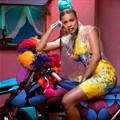#DI2020: How Sho Madjozi brought traditional Tsonga xibelani into 2020
So much so that MC Lebo Mashile’s introduction pronounced Madjozi as “storyteller, important thinker of her generation and fantastic person overall. In fact, I’m not sure she’s a person; she’s a phenomenon!”
Roots: From hair to culture
There’s truth to this statement, as Madjozi’s responsible for the rainbow of purple, yellow and blue braids favoured by South African school girls on their school break.
But Madjozi went beyond hair in her talk to speak of the roots of Tsonga culture, especially the xibelani skirts she’s creating demand for, kicking off Design Indaba’s silver jubilee celebration in an explosive way.
She started off by showing the trailer of the ‘History of Xibelani’ video she’s been working on for a while now:
Culture-rich movie moves
A work in progress, it’s a fascinating glimpse at daily life that showcases the importance of colour and shape in the traditional skirts, and how they’ve been made from all manner of materials through the ages, from grass to maize-meal bags and the now-popular wool, though there wasn’t always choice involved – it was often the only clothing item owned.
She showed a picture from the 1800s, where the item resembled a cloth tied around the waist with a rope – often without a top. This was referred to as ‘clothes’.
Madjozi’s reasoning for bringing the item to the forefront of culture is thus:
If we only wear it on special occasions, who are we the rest of the time?Madjozi has succeeded in bringing this traditional item to the local and even global radar, and admits she’s been answering the question of why she’s wearing what she’s wearing for a while now.
The first time she appeared in public as her Sho Madjozi persona she was wearing one, and she admits there was already a lot of hullabaloo at the time. But the xibelani is a way to accentuate the figure, which has been the way of female fashion forever.
What interests Madjozi in this regard is the public vs private nature of the garment, and what it means for women navigating patriarchy today.
Hidden shapes, layered fashion
She also featured the dovani, usually only worn in the house as an undergarment to the xibelani to help create the shape. It’s rare to find images of this as they are not worn in public.
Madjozi included a male ‘ramp model’ to show that drag was also quite normal in Tsonga culture.
Xibelani made of sacks could be quite bulky, but the form of xibelani that most serves as a status symbol is the dignified beaded tinguvu, around since the early 1900s and still seen as a symbol of wealth and status.
These are usually made from dark, woven cloth adorned with white beads that make them both heavy and expensive. A prized possession, these are gifted on wedding days or for initiation, as they are very time-consuming and expensive to make.
On being loud, taking up space and democracy
The wool xibelani are loud, taking up space and democracy as they emerged after the end of apartheid. These are lighter to wear, cheaper to make and the most iconic form of xibelani to Madjozi as this is the era she grew up in – some were so big they had to be carried on top of the car to the ceremony!
From then, fashion moved from the wool xibelani to the one most recognised today, the xilemba. This Is the xibelani of today.
Usually bought ready-made, these easily contain 10m of material, pleated together and needing to be unraveled when washed, “as no washing line is long enough".
Xilemba are preferred for the street bash competitions popular in Johannesburg townships and a village version that moves around Limpopo.
And this is the context in which Sho Madjozi emerges: A young person who has taken on this ancient clothing item and uses it in her art.
It’s not an African idea to cover up the body, but the xilemba says, 'I have the right to dress colourfully and lightly, without losing my tradition.'Past and present well-explained, Madjozi said “Culture has always evolved, to stay alive.” She envisions the future of the xilemba as part of a carnival festival, putting Limpopo on the map. We shouldn’t aim to museum-ify traditional items: We should always be open to change, in keeping cultue alive.
Madjozi ended her session with a live performance of ‘John Cena’, which had the early-morning crowd on its feet. “Chi chi chi, Sho Madjozi!”
For more:
www.designindaba.com


















